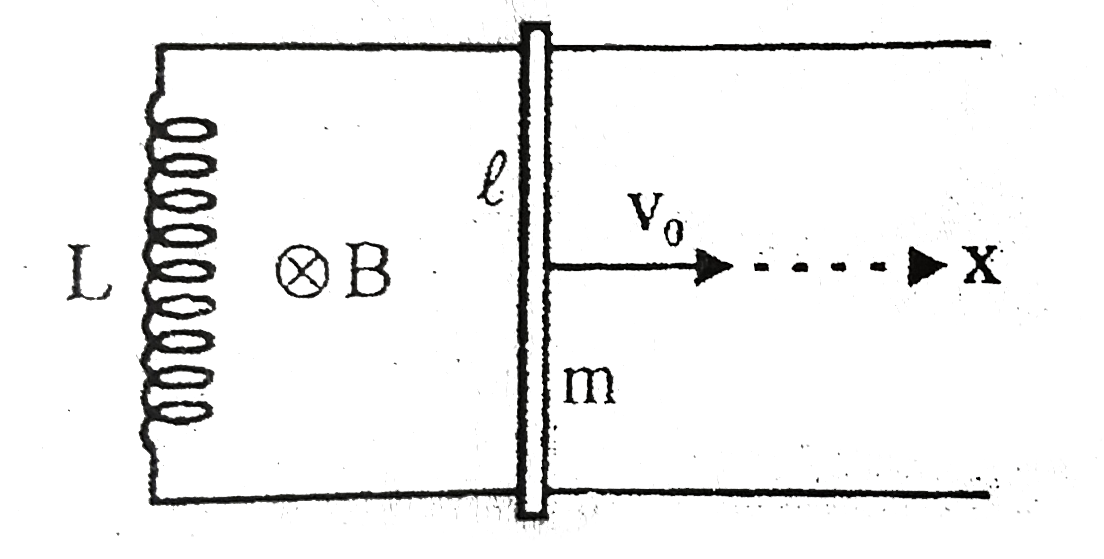A loop is formed by two parallel conductors connected by a selenoid with inductance L and a condutcing rod of mass which can freely (without friction) slide over the conductors. The conductors are located i a horizontal plane in as uniform vertical magnetic field B.The distance between the conductors is l.

At the moment t=0 the rod is impaert dan initial velocity v0 directed to the right. find the law of its motion d(t) if the electric resistance of the loop is negligible
Let at any instant of time velocity of the rod is v towards right. The current in the circuit is i. In the figure.

Va−Vb=Vd−Vc
or L=didt=Bvl=Bldxdt ( as v=dxdt)
i.e., Ldi=Bldx
Integrating on both side we get
Li=Blx
or i=BlLx..........i
Magnetic fore on the rod at this instant is
Fm=ilB=B2l2Lx............ii
Since, this force is in opposite direction of v, so from newton's second law we can write
m(d2xdt2)=−B2l2Lx
or (d2xdt2)=−B2l2mLx
comparing this with equation of SHM,
dxdt2=−ω2x
We have ω=Bl√mL
Therefore, the rod will oscillate simple harmonically with angular frequency ω=Bl√mL. At time t=0, rod was at x=0 and it was moving towards positive x-axis.Hence x−t equation of the rod is
x=Asinωt.........iii
To find A , we use the fact that at t=0,v or dxdt has a value v0. Hence,
dxdt=v=Aωcosωt
or Aω=v0(at t=0)
or A=v0ω
substitutng in Eqn iii we have
x=v0ωsinωt, where ω=Bl√mL
At x=A,v=0 i.e. whole of its kinetic energy is converted into magnetic energy. Thus,
12Li2=12mv20
Substituting value of i from Eq. (i), with x=A, we have
L(BlLA)2=mv20
or A=√mLBlv0=v0ω
as ω=Bl√mL
Topper's Solved these Questions
- ELECTROMAGNETIC INDUCTIONBOOK - DC PANDEYCHAPTER - ELECTROMAGNETIC INDUCTIONEXERCISE - Miscellaneous Examples
5 Videos
- ELECTROMAGNETIC INDUCTIONBOOK - DC PANDEYCHAPTER - ELECTROMAGNETIC INDUCTIONEXERCISE - Exercise 27.1
8 Videos
- ELECTROMAGNETIC INDUCTIONBOOK - DC PANDEYCHAPTER - ELECTROMAGNETIC INDUCTIONEXERCISE - Example Type 5
2 Videos
- CURRENT ELECTRICITYBOOK - DC PANDEYCHAPTER - CURRENT ELECTRICITYEXERCISE - Medical entrances gallery
97 Videos
- ELECTROMAGNETIC WAVESBOOK - DC PANDEYCHAPTER - ELECTROMAGNETIC WAVESEXERCISE - Sec C
22 Videos
Similar Questions
A loop is formed by two parallel conductors connected by a solenoid with inductance L and a conducting rod of mass m which can freely (without friction) slide over the conductors. The conductors are located in a horizontal plane in a uniform vertical magnet field B . the distance between the conductors is l . At the moment t=0 , the rod is imparted an initial velocity v0 directed to the right. Find the law of its motion x(t) if the electric resistance of the loop is negligible.

View SolutionA loop (figure) is formed by two parallel conductores connected by a solenoid with inductance L and a conducting rod of mass m which can freely ( without friction) slide over the conductors. The conductors are located in a horizontal plane in a uniform vertical magnetic field with induction B. The distance between the conductors is equal to l. At the moment t=0 the rod is imparted an initial velocity υ0 directed to the right. Find the law of its motion x(t) if the electric resistance of the loop is negligible.

View Solution
Knowledge Check
A loop is formed by two parallel conductors connected by a solenoid with inductance L=2H and a conducting rod of mass m=80g, which can freely (without fricition) slide over the conductors. The conductors are located in a horizontal plane in a uniform vertical magnetic field with induction B=4T.
The distance between the conductors is equal to l=4cm. At the moment t=0 the rod is imparted an initial velocity v0=2cm/s directed to the right. Find the amplitude (in cm) for the oscillations of conducting rod, if the electric resistance of the loop is negligible.
 A0.25 cmB5 cmC0.5 cmD2.5 cm
A0.25 cmB5 cmC0.5 cmD2.5 cmA loop is formed by two parallel conductors connected by a solenoid with inductance L and a conducting rod of mass M which can freely slide over the conductors. The conductors are located in a uniform magnetic field with induction B perpendicular to the plane of loop. The distance between conductors is l. At t = 0, the rod is given a velocity v0 directed toward right and the current through the inductor is initially zero (below figure) .
 AThe maximum current in circuit during the motion of rod is v0√M/LBThe rod moves for some distance and comes to permanently restCThe velocity of rod when current in the circuit is half of maximum is (√3/2)v0DThe rod oscillates in SHM
AThe maximum current in circuit during the motion of rod is v0√M/LBThe rod moves for some distance and comes to permanently restCThe velocity of rod when current in the circuit is half of maximum is (√3/2)v0DThe rod oscillates in SHMA conductor PQ , with PQ=r , moves with a velocity v in a uniform magnetic field of induced B . The emf induced in the rod is
A(→v×→B).→rB→v.(→r×→B)C→B.(→r×→v)D∣∣→r×(→v×→B)∣∣
A conductor is moving with velocity v in a region of uniform magnetic field B.The electric field at P inside conductor is
View SolutionA current-carrying conductor placed in a uniform magnetic field experiences maximum force when the conductor is placed parallel to the magnetic field.
View SolutionA coducting rod of mass m=0.3kg and length l=4m can slide without friction on two parallel conducting rails. The conducting rails are connected via an inductancce L=3Mh. This system is placed in a region containing uniform magnetic field B=1T pointing into the plane. if the rod is given an initial velocity v0=2m/s, it oscillates with an amplituude Acm. Find the value of 2A

View SolutionA conductor of length l and mass m can slide without any friction along the two vertical conductors connected at the top through a capacitor. A uniform magnetic field B is set up ⊥ to the plane of paper. The acceleration of the conductor

View SolutionA conducting rod of length l is falling with a velocity v perpendicular to a uniform horizontal magnetic field B. The potential difference between the two ends will be
View Solution
